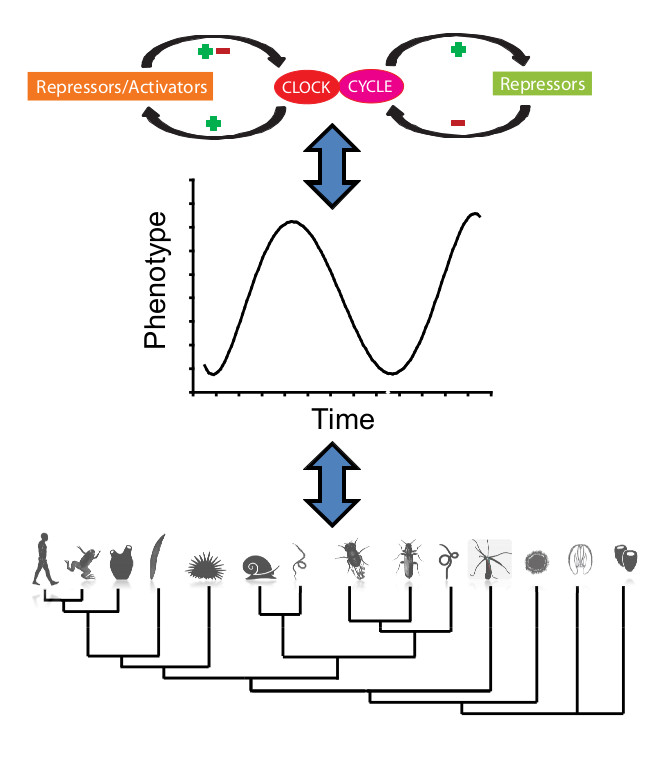SICB Annual Meeting 2013
January 3-7, 2013
San Francisco, CA
Symposium: Keeping time during animal evolution: conservation and innovation of the circadian clock
Diurnal and seasonal cues play critical and conserved roles in behavior, physiology, and reproduction in diverse animals. The circadian clock is a transcription-translation feedback loop that represents the molecular mechanism underlying many of these periodic processes, frequently through responses to light. In this symposium, we will bring together researchers studying these molecular processes and their phenotypic output in diverse animals spanning the animal kingdom, with a focus on invertebrates. An emerging theme from comparative studies of circadian processes is that the genes involved in rhythmic responses can vary considerably from the clock components defined in mammals and Drosophila. However, because many components and their protein level interactions are conserved in these disparate lineages (vertebrates and insects), the evidence strongly supports a hypothesis for an ancient origin of the time-keeping mechanism with many lineage-specific diversification events.
Our symposium will bring together researchers working in diverse systems and at different levels of the biological hierarchy to synthesize our current understanding of the circadian clock in an evolutionary context and to focus future efforts to answer critical questions. The symposium will present novel research related to the circadian clock in newly emerging model invertebrates and circadian function in insects and vertebrates, for which there is a longer tradition of understanding the molecular mechanisms.
Sponsors: Society for Integrative and Comparative Biology, Divisions DCPB, DEE, DNB, DIZ, American Microscopical Society (AMS)
 This material is based upon work supported by the National Science Foundation under Grant Number 1239607 from the Integrative Organismal Systems Program.
This material is based upon work supported by the National Science Foundation under Grant Number 1239607 from the Integrative Organismal Systems Program.
Organizers
- Adam M. Reitzel
- Ann M. Tarrant
Speakers
S7-1.1 Sunday, Jan. 6, 08:00 MÜLLER, W.E.G. *; WANG, X.H. :
Metazoan circadian rhythm: an universal “Zeitgeber” existing from sponges to humans
S7-1.2 Sunday, Jan. 6, 08:30 REITZEL, A.M.*; TARRANT, A.M.:
Circadian clock of the starlet sea anemone Nematostella vectensis: a conserved network and missing links
S7-1.3 Sunday, Jan. 6, 09:00 LIWANG, A.*; CHANG, Y.-G.; TSENG, R. D.:
Rhythmic Ring-Ring Stacking Drives the Circadian Oscillator Clockwise
S7-1.4 Sunday, Jan. 6, 09:30 DE LA IGLESIA, Horacio O.; SMARR, B.*:
Finding A Temporal Niche
S7-1.5 Sunday, Jan. 6, 10:30 BATTELLE, Barbara-Anne:
What the clock tells the eye: Lessons from an ancient arthropod
S7-1.6 Sunday, Jan. 6, 11:00 MERRITT, DJ*; MAYNARD, AJ:
Synchronization of circadian bioluminescence as a group-foraging strategy in cave glowworms
S7-1.7 Sunday, Jan. 6, 11:30 OLIVERI, P*; PETRONE , L; LERNER, A; MATTIELLO, T:
Evolution of animal clock: an echinoderm prospective
S7-2.1 Sunday, Jan. 6, 13:00 LOUDON, FK; SPENCER, R-J*:
Egging each other on: embryonic communication in a nest maintains circadian rhythms of heart rate in turtles?
S7-2.2 Sunday, Jan. 6, 13:30 HEATH-HECKMAN, Elizabeth A.C.*; PEYER, Suzanne M.; MCFALL-NGAI, Margaret J.:
Symbiont luminescence entrains daily host-tissue rhythms through direct regulation of a host cryptochrome gene
S7-2.3 Sunday, Jan. 6, 14:00 MEUTI, Megan E.*; DENLINGER, David L.:
The Role of Circadian Clock Genes in the Overwintering Diapause of the Northern House Mosquito, Culex pipiens
S7-2.4 Sunday, Jan. 6, 14:30 REPPERT, SM:
The monarch butterfly reveals the prototype ancestral TTFL clock of insects: a focus on cryptochromes
Student Support:
Some additional support will be available for students presenting in an accompanying session.
Please contact the organizers if you are interested in being considered for funding.


